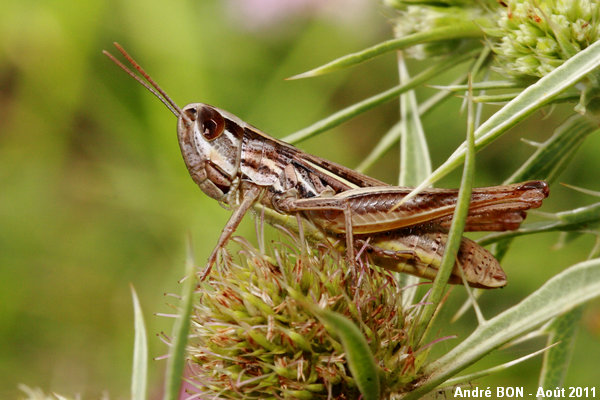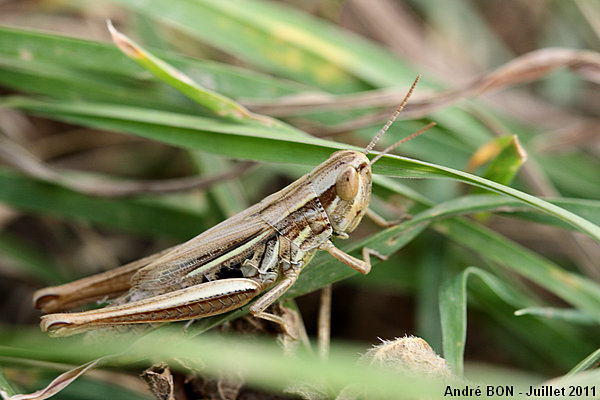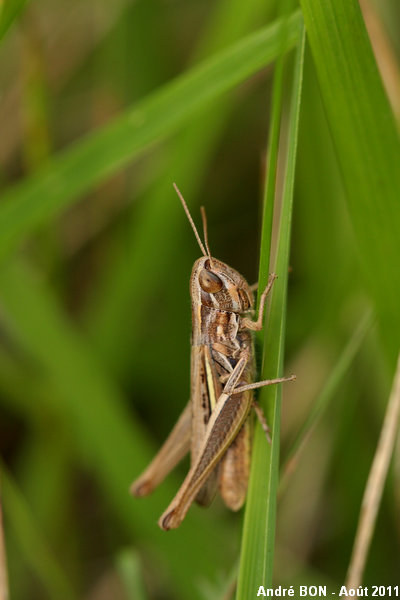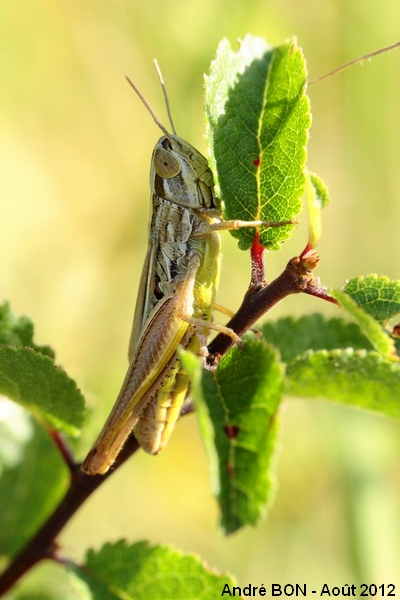




| Sharp-tailed Grasshopper (Euchorthippus declivus (Brisout de Barneville, 1848)) |





|
|
Scientific name: Euchorthippus declivus (Brisout de Barneville, 1848) Common name: Sharp-tailed Grasshopper French name: Criquet des bromes, Criquet des mouillères Order: Orthoptera Family: Acrididae Wingspan : Males: 14-20 mm; Females: 20-27 mm. Biotope: Dry meadows, slopes facing south, edges of cultivated areas, waste lands. Geographic area: Europe. Observation period : July to October. |
The Sharp-tailed Grasshopper, like other Chorthippus, shows a small lobe on the outer edge of the elytra or tegmina, near the base. This grasshopper is a greenish yellow to pale brown colour. The head is rather large and shows a blackish postocular stripe. The tip of the antennae is the same colour as the other parts of the antennae. The keels on the upper side of the pronotum are straight. The central keel extends as a thin carinula on the top of the vertex. The lateral keels extends to the back of the eyes on the upper edge of the dark postocular stripe. The tegmina are rather short. They do not exceed the mid length of the hind femora on females and they do not reach the knees on males. They show a whitish yellow longitudinal band next to the fore edge. Males show a thin conical-shaped sub-genital plate at the abdomen tip. The Lesser Marsh Grasshopper (Chorthippus albomarginatus) also shows straight keels and one whitish yellow stripe (often missing on males) on the fore edge of the tegmina. Its tegmina are longer than those of the Sharp-tailed Grasshopper and reach the knees. The median vein suddenly diverges from the radial vein in the middle of the elytra. The Lesser Marsh Grasshopper prefers damp habitats. The Jersey Grasshopper (Euchorthippus elegantulus) has white antenna tips. The males' wings reach the knees, the females' ones almost. The Toothlegged Grasshopper (Euchorthippus chopardi) has longer tegmina. They reach the knees on females. The sub-genital plate on males is shorter than on the other species. |
| [To know more about the Sharp-tailed Grasshopper] [Next picture] [Top] |

|
The natural light being two week, I have increased ISO sensitivity to 800 and my old digital camera does not perform very well with these high sensitivity settings. I have set camera exposure correction to -1 and I have used the flash with a flash correction set to +1. The result is correct. The main subject is lightened and the background does not appear too dark. |
| [To know more about the Sharp-tailed Grasshopper] [Next picture] [Previous picture] [Top] |

|
I think that this one is a female Sharp-tailed Grasshopper. The back end of the tegmina is about at mid length of the hind femora. |
| [To know more about the Sharp-tailed Grasshopper] [Next picture] [Previous picture] [Top] |

|
I think that this one is a male Sharp-tailed Grasshopper. The tegmina end beyond half femur but do not reach the knees. |
| [To know more about the Sharp-tailed Grasshopper] [Next picture] [Previous picture] [Top] |

|
Front view. |
| [To know more about the Sharp-tailed Grasshopper] [Previous picture] [Top] |

|
This leaf belongs to me! Don't touch! |